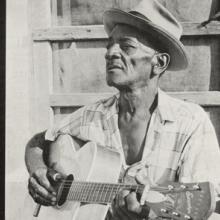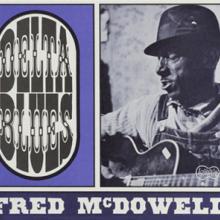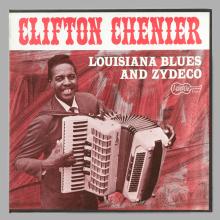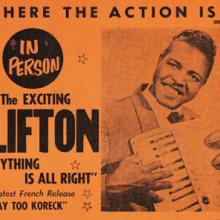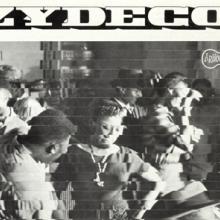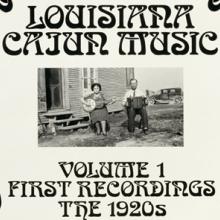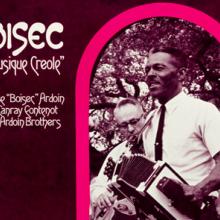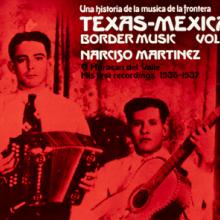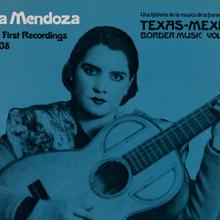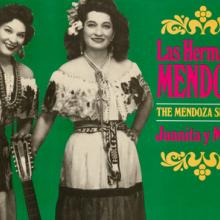Terminal 2












“Texas Songster” Mance Lipscomb
Arhoolie Records | Released 1960
Cover photograph: Chris Strachwitz
Graphic design: Wayne Pope
Courtesy of Chris Strachwitz and/or the Arhoolie Foundation
LP 1001
L2018.1101.002.01-.03
 Born in Texas, Mance Lipscomb (1895–1976), the first artist Chris Strachwitz released on his Arhoolie label, worked for decades as a tenant farmer. Lipscomb referred to himself as a “songster;” his vast repertoire included everything from blues to narrative ballads, spirituals, popular songs, dance tunes, children’s songs, and work songs dating from the nineteenth and twentieth centuries. After recording with Strachwitz, he became a pivotal figure on the folk music scene, performing for audiences around the country.
Born in Texas, Mance Lipscomb (1895–1976), the first artist Chris Strachwitz released on his Arhoolie label, worked for decades as a tenant farmer. Lipscomb referred to himself as a “songster;” his vast repertoire included everything from blues to narrative ballads, spirituals, popular songs, dance tunes, children’s songs, and work songs dating from the nineteenth and twentieth centuries. After recording with Strachwitz, he became a pivotal figure on the folk music scene, performing for audiences around the country.
“Delta Blues” Mississippi Fred McDowell 1964
Arhoolie Records | Released 1964
Cover photograph: Chris Strachwitz
Graphic design: Wayne Pope
Courtesy of Chris Strachwitz and/or the Arhoolie Foundation
LP 1021
L2018.1101.015
 Delta bluesman Mississippi Fred McDowell (1904–72) was born in Tennessee but later moved to Mississippi. He learned to play the guitar in his youth. He played the bottleneck slide guitar, in which a glass bottleneck is placed on the finger and pressed across multiple strings on the fingerboard to produce a sliding, whining sound. McDowell played at local house dances and gatherings while working as a farmer. Ethnomusicologist Alan Lomax “discovered” the bluesman at his farm in 1959 and recorded him performing blues and spirituals. But it was not until Chris Strachwitz, who obtained his address from Lomax, recorded the obscure blues giant in 1964, that he became more widely known at folk and blues festivals and clubs. McDowell influenced numerous musicians such as Bonnie Raitt, who considered McDowell her greatest mentor. This is the definitive first Mississippi Fred McDowell solo album. Strachwitz recorded it the same evening he first met him.
Delta bluesman Mississippi Fred McDowell (1904–72) was born in Tennessee but later moved to Mississippi. He learned to play the guitar in his youth. He played the bottleneck slide guitar, in which a glass bottleneck is placed on the finger and pressed across multiple strings on the fingerboard to produce a sliding, whining sound. McDowell played at local house dances and gatherings while working as a farmer. Ethnomusicologist Alan Lomax “discovered” the bluesman at his farm in 1959 and recorded him performing blues and spirituals. But it was not until Chris Strachwitz, who obtained his address from Lomax, recorded the obscure blues giant in 1964, that he became more widely known at folk and blues festivals and clubs. McDowell influenced numerous musicians such as Bonnie Raitt, who considered McDowell her greatest mentor. This is the definitive first Mississippi Fred McDowell solo album. Strachwitz recorded it the same evening he first met him.
"Big Mama Thornton with Muddy Waters’ Blues Band
"
Big Mama Thornton
Arhoolie Records | Released 1967
Cover photograph: Jim Marshall
Courtesy of Chris Strachwitz and/or the Arhoolie Foundation
LP 1032
L2018.1101.007
 Powerful rhythm-and-blues singer Big Mama Thornton (1926–84) was first to record the songs “Hound Dog” and her own composition, “Ball n’ Chain,” which would later be made famous by Elvis Presley and Janis Joplin. Growing up in Alabama with a minister for a father, Thornton began singing in church at an early age; she also learned to play the harmonica and drums. Her career began to flourish after she moved to Houston, Texas. In the late 1950s, as rock-and-roll became more popular and her career began to wane, she relocated to the Bay Area, performing at local clubs. During the 1960s folk music revival, she made several records with Arhoolie and performed at a number of festivals in the United States and Europe.
Powerful rhythm-and-blues singer Big Mama Thornton (1926–84) was first to record the songs “Hound Dog” and her own composition, “Ball n’ Chain,” which would later be made famous by Elvis Presley and Janis Joplin. Growing up in Alabama with a minister for a father, Thornton began singing in church at an early age; she also learned to play the harmonica and drums. Her career began to flourish after she moved to Houston, Texas. In the late 1950s, as rock-and-roll became more popular and her career began to wane, she relocated to the Bay Area, performing at local clubs. During the 1960s folk music revival, she made several records with Arhoolie and performed at a number of festivals in the United States and Europe.
“Texas Blues Man” Lightnin' Hopkins
Arhoolie Records | Released 1968
Cover photograph: Chris Strachwitz
Graphic design: Wayne Pope
Courtesy of Chris Strachwitz and/or the Arhoolie Foundation
LP 1034
L2018.1101.008
 Born in Centerville, Texas, country bluesman Lightnin’ Hopkins (1912–82) learned to play the guitar from his older brother John Henry Hopkins. A prolific songwriter, he recorded nearly two-hundred songs during his career, which began in the 1940s and ended in the early 1980s. Hopkins inspired Chris Strachwitz to start his Arhoolie record label. In 1959, Strachwitz traveled to Houston, Texas, where he saw Hopkins perform in an informal beer joint and was struck by his improvised lyrics and spontaneous exchange with the audience. Arhoolie would release its first recording of Hopkins in 1968.
Born in Centerville, Texas, country bluesman Lightnin’ Hopkins (1912–82) learned to play the guitar from his older brother John Henry Hopkins. A prolific songwriter, he recorded nearly two-hundred songs during his career, which began in the 1940s and ended in the early 1980s. Hopkins inspired Chris Strachwitz to start his Arhoolie record label. In 1959, Strachwitz traveled to Houston, Texas, where he saw Hopkins perform in an informal beer joint and was struck by his improvised lyrics and spontaneous exchange with the audience. Arhoolie would release its first recording of Hopkins in 1968.
“Louisiana Blues and Zydeco” Clifton Chenier
Arhoolie Records | Released 1966
Cover photograph: Chris Strachwitz
Graphic design: Wayne Pope
Courtesy of Chris Strachwitz and/or the Arhoolie Foundation
LP 1024
L2018.1101.053
 Over time, the traditional Cajun waltzes and two-steps played on the accordion fused with rhythm-and-blues, blues, and eventually, rock-and-roll to create a uniquely new Creole sound called zydeco. Clifton Chenier (1925–87), considered the “King of Zydeco,” invented and popularized the musical genre to audiences nationwide as well as in Europe. Chenier’s father, a farmer, played music on the accordion at Creole dances. Rather than use the traditional button accordion typical in Cajun and Creole music, Chenier played a piano accordion, which can play in any key. In the early 1950s, Chenier made his first recordings. While playing music, he worked in various trades including agriculture and truck driving for oil refineries. Chris Strachwitz first met Chenier in 1964 in Houston, Texas, after being introduced by Lightnin’ Hopkins, Chenier’s cousin. After Strachwitz recorded Chenier in the mid-1960s, the musician became more widely known. Chenier performed at Creole dances, various festivals throughout the U.S. and Europe, and he continued to perform into the 1980s, even with his health in decline.
Over time, the traditional Cajun waltzes and two-steps played on the accordion fused with rhythm-and-blues, blues, and eventually, rock-and-roll to create a uniquely new Creole sound called zydeco. Clifton Chenier (1925–87), considered the “King of Zydeco,” invented and popularized the musical genre to audiences nationwide as well as in Europe. Chenier’s father, a farmer, played music on the accordion at Creole dances. Rather than use the traditional button accordion typical in Cajun and Creole music, Chenier played a piano accordion, which can play in any key. In the early 1950s, Chenier made his first recordings. While playing music, he worked in various trades including agriculture and truck driving for oil refineries. Chris Strachwitz first met Chenier in 1964 in Houston, Texas, after being introduced by Lightnin’ Hopkins, Chenier’s cousin. After Strachwitz recorded Chenier in the mid-1960s, the musician became more widely known. Chenier performed at Creole dances, various festivals throughout the U.S. and Europe, and he continued to perform into the 1980s, even with his health in decline.
Clifton Chenier and his Red Hot Louisiana Band poster 1969
French Dance-Music Hall
Courtesy of Chris Strachwitz and/or the Arhoolie Foundation
L2018.1101.087
Blue Monday Blues poster featuring
Lightning Hopkins and Clifton Chenier 1967
Presented by the Pretentious Folk Front
UC Berkeley
Courtesy of Chris Strachwitz and/or the Arhoolie Foundation
L2018.1101.039
 Chris Strachwitz recalled in the film This Ain’t No Mouse Music that he would never have met Clifton Chenier if he hadn’t hung out with Lightnin’ Hopkins, Chenier’s cousin. Lightnin’ invited him to hear his cousin play in Houston. Strachwitz explained, “Any place Lightnin’ wanted to go, I went, you know; I’ll never forget that evening. It was what they called a beer joint. People don’t really realize that there were no concerts where you heard these artists. There wasn’t even a stage in this little joint, and here was this lanky, tall Black man with just an accordion singing this most amazing blues in this weird patois I had never heard.”
Chris Strachwitz recalled in the film This Ain’t No Mouse Music that he would never have met Clifton Chenier if he hadn’t hung out with Lightnin’ Hopkins, Chenier’s cousin. Lightnin’ invited him to hear his cousin play in Houston. Strachwitz explained, “Any place Lightnin’ wanted to go, I went, you know; I’ll never forget that evening. It was what they called a beer joint. People don’t really realize that there were no concerts where you heard these artists. There wasn’t even a stage in this little joint, and here was this lanky, tall Black man with just an accordion singing this most amazing blues in this weird patois I had never heard.”
“Zydeco” Various Artists
Arhoolie Records | Released 1967
Cover photograph: Chris Strachwitz
Graphic design: Wayne Pope
Courtesy of Chris Strachwitz and/or the Arhoolie Foundation
LP 1009
L2018.1101.059
 This compilation features formative and historical players including Clifton Chenier, Willie Green, Albert Chevalier, and Lightnin’ Hopkins on organ, mostly recorded live in Houston, Texas, beer joints and houses. The word zydeco derives from a popular regional saying: “les haricots ne sont pas salés” or “the snap beans aren’t salty.”
This compilation features formative and historical players including Clifton Chenier, Willie Green, Albert Chevalier, and Lightnin’ Hopkins on organ, mostly recorded live in Houston, Texas, beer joints and houses. The word zydeco derives from a popular regional saying: “les haricots ne sont pas salés” or “the snap beans aren’t salty.”
“Louisiana Cajun Music, Volume 1, First Recordings: The 1920s” Various Artists
Old Timey Records | Released 1970
Graphic design: Wayne Pope
Courtesy of Chris Strachwitz and/or the Arhoolie Foundation
LP 108
L2018.1101.073
 In 1928, accordion player Joseph Falcon (1900–65) made the first Cajun recording, “Allons à Lafayette” for Columbia Records with his wife Cléoma Breaux Falcon (1906–41) in New Orleans. The popularity of the record led Falcon to become the first Cajun recording star. Falcon played the accordion while his wife Cléoma played a National steel body guitar.
In 1928, accordion player Joseph Falcon (1900–65) made the first Cajun recording, “Allons à Lafayette” for Columbia Records with his wife Cléoma Breaux Falcon (1906–41) in New Orleans. The popularity of the record led Falcon to become the first Cajun recording star. Falcon played the accordion while his wife Cléoma played a National steel body guitar.
The French-speaking settlers who left the Acadian region of Canada for southwest Louisiana in 1764 became known as Cajuns. They brought their traditional ballads and fiddle tunes with them. Music was an essential part of social life among Cajuns at house parties, gatherings, and by the 1920s, at dancehalls. Over time, French-speaking African American Creoles also shared these music traditions. In the days before amplification or microphones, singers had to project their voices high and loud in order to be heard. Even after amplified sound was introduced in the mid-1930s, this characteristic singing style remained the standard among most traditional Cajun vocalists. The fiddle most often accompanied singing. The accordion, introduced by German immigrants to the United States, was incorporated into the Cajun and Creole repertoire around the turn of the twentieth century. The loud, sturdy instrument had a significant effect on the sound of Cajun/Creole music. Lyrics are still sung in French today.
“La Musique Creole” Alphonse “Boisec” Ardoin with Canray Fontenot & The Ardoin Brothers
Arhoolie Records | Released 1975
Cover photograph: Chris Strachwitz
Graphic design: Wayne Pope
Courtesy of Chris Strachwitz and/or the Arhoolie Foundation
LP 1070
L2018.1101.063
 The magnetic and adept accordionist Alphonse Ardoin (1915–2007) received the nickname Bois Sec, “dry wood,” because of how quickly he took cover during Louisiana rainstorms while working in the fields as a child. In the late 1920s, his cousin Amadé Ardoin made the first 78-rpm recordings of French Creole music.
The magnetic and adept accordionist Alphonse Ardoin (1915–2007) received the nickname Bois Sec, “dry wood,” because of how quickly he took cover during Louisiana rainstorms while working in the fields as a child. In the late 1920s, his cousin Amadé Ardoin made the first 78-rpm recordings of French Creole music.
Canray Fontenot’s (1922–95) father and uncle both played the button accordion, but his cousin, fiddler Douglas Belair had the most influence on the musician. Fontenot was one of the most talented and charismatic Creole fiddlers. He made his first fiddle from a wooden cigar box around the age of nine—by age eleven he received a real one. He soon began playing with his father at local dances and events.
In 1948, Ardoin and Fontenot began playing together as the Duralde Ramblers at house dances. They continued to play together for more than forty years. In 1966, they performed together at the Newport Folk Festival in Rhode Island. Both received National Heritage Fellowships from the National Endowment for the Arts in 1986. On the first side of this album, the two play together. On the second side, Fontenot plays with Ardoin’s sons.
“Texas-Mexican Border Music Volume 10” Narciso Martínez
Folklyric | Released 1978
Cover photograph: Narciso Martínez
Graphic design: Wayne Pope
Courtesy of Chris Strachwitz and/or the Arhoolie Foundation
LP 9017
L2018.1101.115
 The father of Texas-Mexican conjunto/norteño and its most influential early accordion player, Narciso Martínez (1911–92) made his first recordings in 1936, which this album contains. According to Chris Strachwitz,“Narciso was a fast and snappy player…so efficient at the accordion that he was able to record twenty titles in one day.” He then received the title, “El Huracan del Valle,” (The Hurricane of the Valley). When he became the house accordionist for Ideal Records in San Benito, Texas, in 1946, he accompanied many popular singers, such as sisters Carmen & Laura Hernández, on commercial records. By doing so, he popularized what is now known as conjunto/norteño with an accordionist and bajo sexto player backing a duet.
The father of Texas-Mexican conjunto/norteño and its most influential early accordion player, Narciso Martínez (1911–92) made his first recordings in 1936, which this album contains. According to Chris Strachwitz,“Narciso was a fast and snappy player…so efficient at the accordion that he was able to record twenty titles in one day.” He then received the title, “El Huracan del Valle,” (The Hurricane of the Valley). When he became the house accordionist for Ideal Records in San Benito, Texas, in 1946, he accompanied many popular singers, such as sisters Carmen & Laura Hernández, on commercial records. By doing so, he popularized what is now known as conjunto/norteño with an accordionist and bajo sexto player backing a duet.
“Texas-Mexican Border Music Vol. 15, Part 1: First Recordings 1928–38” Lydia Mendoza
Folklyric | 1979
Graphic design: Wayne Pope
Courtesy of Chris Strachwitz and/or the Arhoolie Foundation
LP 9023
L2018.1101.113
 Lydia Mendoza (1916–2007), the first true star of Tejano music, nicknamed “La Alondra de la Frontera” (Lark of the Border), was born in Houston to Mexican parents who fled the Mexican Revolution for South Texas. She began singing and playing the guitar in the family group to earn income, performing for tips at restaurants, open markets, and at parties. In 1928, her father responded to an advertisement placed in a newspaper by Okeh Records searching for local talent. The Mendoza family was paid $140 to record a number of songs. In the 1930s, Mendoza began performing on the radio for $3.50 per week after winning an amateur competition on the program La Voz Latina. In 1934, Mendoza recorded her most famous ballad, “Mal Hombre” (Bad Man). Many of her songs explore dark themes of heartbreak and suffering. Her fervent vocals accompanied by her twelve-string guitar have long captivated audiences in Texas and elsewhere in Spanish-speaking America.
Lydia Mendoza (1916–2007), the first true star of Tejano music, nicknamed “La Alondra de la Frontera” (Lark of the Border), was born in Houston to Mexican parents who fled the Mexican Revolution for South Texas. She began singing and playing the guitar in the family group to earn income, performing for tips at restaurants, open markets, and at parties. In 1928, her father responded to an advertisement placed in a newspaper by Okeh Records searching for local talent. The Mendoza family was paid $140 to record a number of songs. In the 1930s, Mendoza began performing on the radio for $3.50 per week after winning an amateur competition on the program La Voz Latina. In 1934, Mendoza recorded her most famous ballad, “Mal Hombre” (Bad Man). Many of her songs explore dark themes of heartbreak and suffering. Her fervent vocals accompanied by her twelve-string guitar have long captivated audiences in Texas and elsewhere in Spanish-speaking America.
“Las Hermanas Mendoza: Juanita y María” Las Hermanas Mendoza
Arhoolie Records | Released 1984
Cover photograph: Andrew Mendoza
Graphic design: Wayne Pope
Courtesy of Chris Strachwitz and/or the Arhoolie Foundation
LP 3017
L2018.1101.103
 Sisters María (1922–90) and Juanita (b. 1927) Mendoza were born in Monterrey, Mexico. Although their sister Lydia Mendoza would become the most famous member of the family, Juanita and María also achieved acclaim performing and recording as the duet Las Hermanas Mendoza beginning in the 1950s. These recordings were licensed from Azteca Records.
Sisters María (1922–90) and Juanita (b. 1927) Mendoza were born in Monterrey, Mexico. Although their sister Lydia Mendoza would become the most famous member of the family, Juanita and María also achieved acclaim performing and recording as the duet Las Hermanas Mendoza beginning in the 1950s. These recordings were licensed from Azteca Records.
